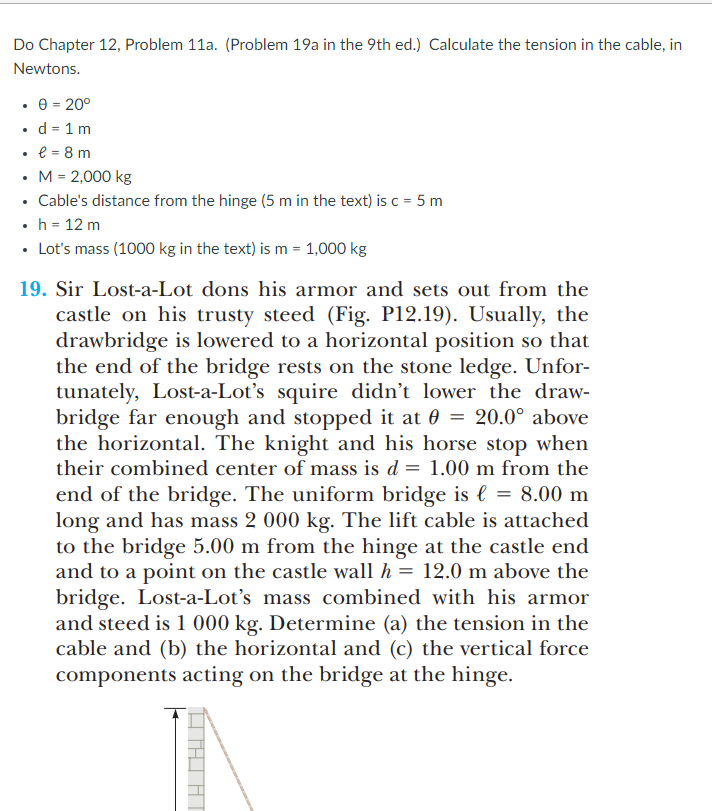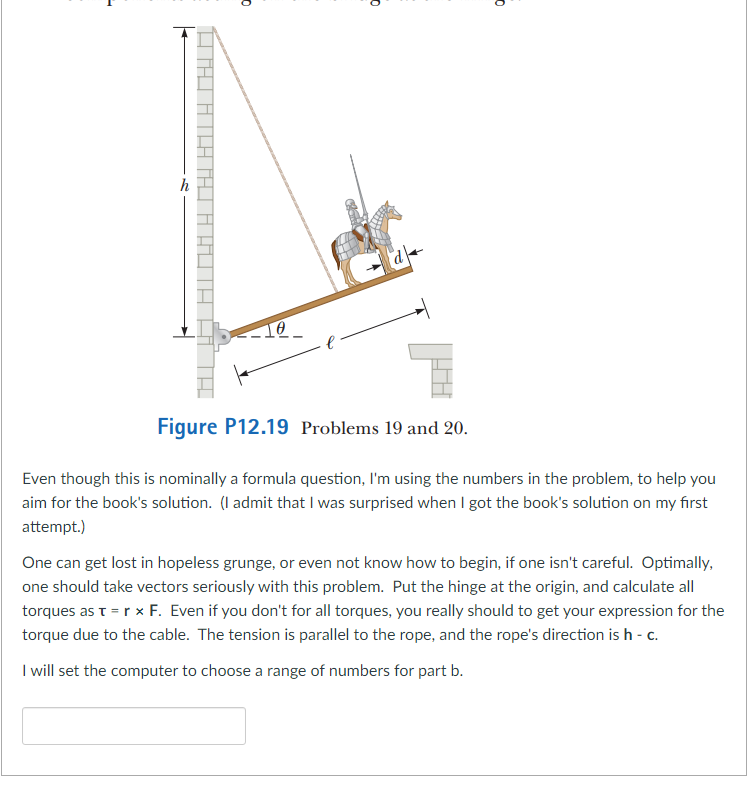19. Sir Lost-a-Lot dons his armor and sets out from the castle on his trusty steed (Fig. P12.19). Usually, the drawbridge is lowered to a horizontal position so that the end of the bridge rests on the stone ledge. Unfor- tunately, Lost-a-Lot's squire didn't lower the draw- bridge far enough and stopped it at 0 = 20.0° above the horizontal. The knight and his horse stop when their combined center of mass is d = 1.00 m from the end of the bridge. The uniform bridge is l = 8.00 m long and has mass 2 000 kg. The lift cable is attached to the bridge 5.00 m from the hinge at the castle end and to a point on the castle wall h = 12.0 m above the bridge. Lost-a-Lot's mass combined with his armor and steed is 1 000 kg. Determine (a) the tension in the cable and (b) the horizontal and (c) the vertical force components acting on the bridge at the hinge.
19. Sir Lost-a-Lot dons his armor and sets out from the castle on his trusty steed (Fig. P12.19). Usually, the drawbridge is lowered to a horizontal position so that the end of the bridge rests on the stone ledge. Unfor- tunately, Lost-a-Lot's squire didn't lower the draw- bridge far enough and stopped it at 0 = 20.0° above the horizontal. The knight and his horse stop when their combined center of mass is d = 1.00 m from the end of the bridge. The uniform bridge is l = 8.00 m long and has mass 2 000 kg. The lift cable is attached to the bridge 5.00 m from the hinge at the castle end and to a point on the castle wall h = 12.0 m above the bridge. Lost-a-Lot's mass combined with his armor and steed is 1 000 kg. Determine (a) the tension in the cable and (b) the horizontal and (c) the vertical force components acting on the bridge at the hinge.
Principles of Physics: A Calculus-Based Text
5th Edition
ISBN:9781133104261
Author:Raymond A. Serway, John W. Jewett
Publisher:Raymond A. Serway, John W. Jewett
Chapter10: Rotational Motion
Section: Chapter Questions
Problem 77P
Related questions
Concept explainers
Rotational Equilibrium And Rotational Dynamics
In physics, the state of balance between the forces and the dynamics of motion is called the equilibrium state. The balance between various forces acting on a system in a rotational motion is called rotational equilibrium or rotational dynamics.
Equilibrium of Forces
The tension created on one body during push or pull is known as force.
Question
100%
Problem 11b asks for the x-component of the force on the bridge due to the hinge. Answer in Newtons. This time, the computer will choose the numbers.
- θ = 17o
- d = 1.1 m
- ℓ = 9 m
- M = 2000 kg
- Cable's distance from the hinge (5 m in the text) is c = 6.7 m
- h = 12 m
- Lot's mass (1000 kg in the text) is m = 1200 kg

Transcribed Image Text:Do Chapter 12, Problem 11a. (Problem 19a in the 9th ed.) Calculate the tension in the cable, in
Newtons.
• e = 20°
d = 1 m
e = 8 m
• M= 2,000 kg
• Cable's distance from the hinge (5 m in the text) is c = 5 m
h = 12 m
• Lot's mass (1000 kg in the text) is m = 1,000 kg
19. Sir Lost-a-Lot dons his armor and sets out from the
castle on his trusty steed (Fig. P12.19). Usually, the
drawbridge is lowered to a horizontal position so that
the end of the bridge rests on the stone ledge. Unfor-
tunately, Lost-a-Lot's squire didn't lower the draw-
bridge far enough and stopped it at 0 = 20.0° above
the horizontal. The knight and his horse stop when
their combined center of mass is d = 1.00 m from the
end of the bridge. The uniform bridge is l = 8.00 m
long and has mass 2 000 kg. The lift cable is attached
to the bridge 5.00 m from the hinge at the castle end
and to a point on the castle wall h = 12.0 m above the
bridge. Lost-a-Lot's mass combined with his armor
and steed is 1 000 kg. Determine (a) the tension in the
cable and (b) the horizontal and (c) the vertical force
components acting on the bridge at the hinge.

Transcribed Image Text:10
Figure P12.19 Problems 19 and 20.
Even though this is nominally a formula question, I'm using the numbers in the problem, to help you
aim for the book's solution. (I admit that I was surprised when I got the book's solution on my first
attempt.)
One can get lost in hopeless grunge, or even not know how to begin, if one isn't careful. Optimally,
one should take vectors seriously with this problem. Put the hinge at the origin, and calculate all
torques as t = rx F. Even if you don't for all torques, you really should to get your expression for the
torque due to the cable. The tension is parallel to the rope, and the rope's direction is h - c.
I will set the computer to choose a range of numbers for part b.
THE
Expert Solution
This question has been solved!
Explore an expertly crafted, step-by-step solution for a thorough understanding of key concepts.
This is a popular solution!
Trending now
This is a popular solution!
Step by step
Solved in 4 steps with 4 images

Knowledge Booster
Learn more about
Need a deep-dive on the concept behind this application? Look no further. Learn more about this topic, physics and related others by exploring similar questions and additional content below.Recommended textbooks for you

Principles of Physics: A Calculus-Based Text
Physics
ISBN:
9781133104261
Author:
Raymond A. Serway, John W. Jewett
Publisher:
Cengage Learning

Physics for Scientists and Engineers: Foundations…
Physics
ISBN:
9781133939146
Author:
Katz, Debora M.
Publisher:
Cengage Learning

Principles of Physics: A Calculus-Based Text
Physics
ISBN:
9781133104261
Author:
Raymond A. Serway, John W. Jewett
Publisher:
Cengage Learning

Physics for Scientists and Engineers: Foundations…
Physics
ISBN:
9781133939146
Author:
Katz, Debora M.
Publisher:
Cengage Learning